Key Insights
- Avalanche achieved impressive QoQ growth in Q4, including market cap (344%), revenue (2,874%), average daily transactions (182%), DeFi TVL (78%), average daily DEX volume (245%), and average daily NFT volume (1,490%).
- Avalanche emerged as one of the top chains for inscriptions. This led to quarterly revenues of $56.5 million, a new all-time high.
- Average daily transactions on subnets rebounded in Q4 (48% QoQ), in part due to the launches of new subnets Beam and Hubble Exchange.
- J.P. Morgan and Citi announced that they were building on Evergreen subnets, which could lead to increased enterprise adoption in the future.
- Avalanche Codebase, a 12-week accelerator program for projects on Avalanche, kicked off in November. Participants have until February 12 to apply.
Primer
Avalanche (AVAX) is a Proof-of-Stake (PoS) smart contract platform for decentralized applications. Avalanche differentiates itself by creating and implementing a consensus family known as “Avalanche consensus.”
Following years of research, the Avalanche mainnet was launched in September 2020 and featured the release of a multichain framework utilizing three chains: the P, X, and C chains. Each chain plays a critical and unique role within the Avalanche ecosystem while providing the same capabilities of a single network, often called the Primary Network. Avalanche consensus and the Primary Network are designed to support sovereign, interconnected blockchains known as subnets.
Subnets are subclasses of Primary Network validators that run the same Virtual Machines (VMs) with their own rules. Subnets enable different properties of reliability, efficiency, and data sovereignty. They provide the ability to create custom blockchains for different use cases while isolating high-traffic applications from congesting activity on the Primary Network.
Website / X (Twitter) / Discord
Key Metrics
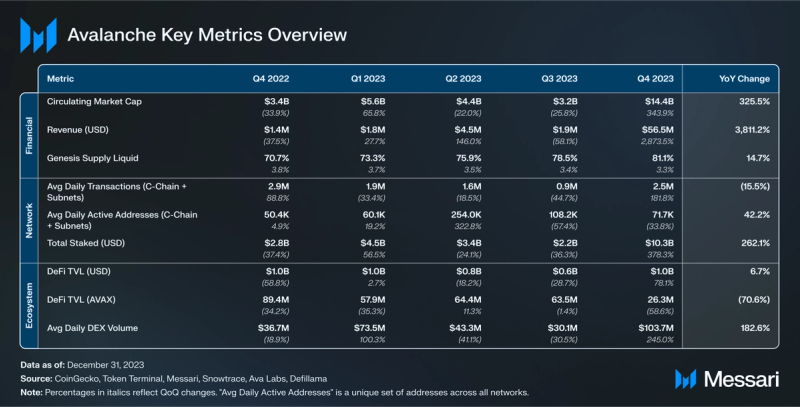
Financial Overview
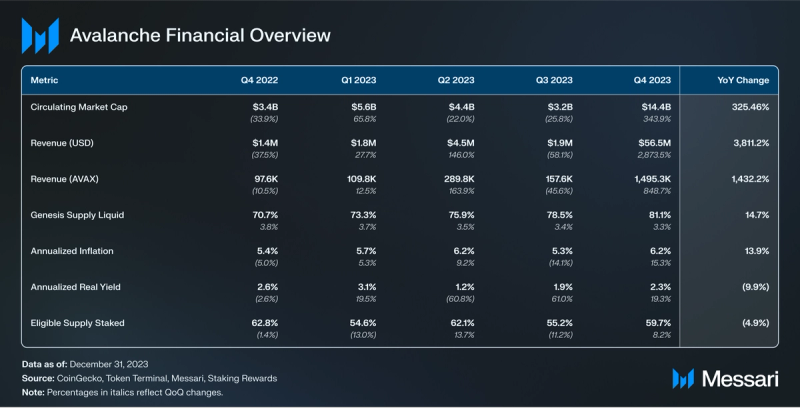
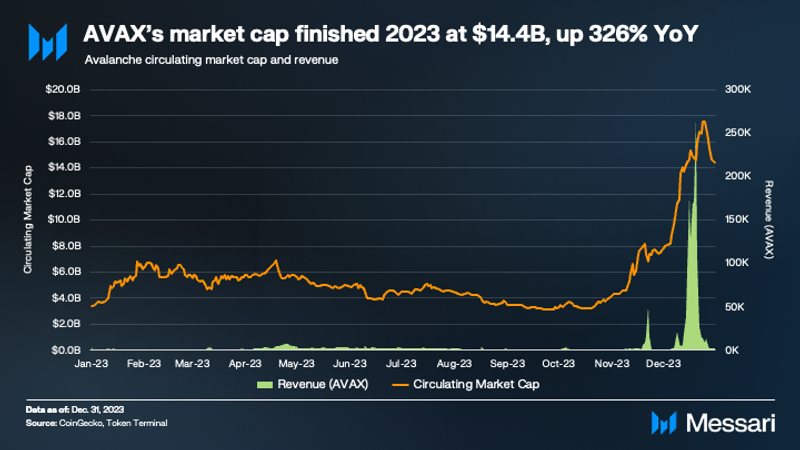
AVAX was one of the best performers for large-cap tokens during the Q4 crypto market rally. It finished the year with a market cap of $14.4 billion, up both 344% QoQ and 326% YoY. By the end of the quarter, AVAX’s market cap rank among all tokens rose by 11 spots from 20 to 9.
Revenue, which measures all gas fees collected by the network, outpaced the gains of AVAX’s market cap and increased by 849% QoQ from 157,600 AVAX to 1.5 million AVAX. Measured in USD, this difference is even more stark as quarterly revenue increased 2,874% from $1.9 million to $56.5 million.
Similar to many other Layer-1 networks, Avalanche saw a big spike in revenue due to inscriptions — specifically, Avascriptions (ACS-20 token). These inscriptions are calldata sent in a transaction. Although this calldata is entirely onchain, offchain indexers actually interpret the calldata and determine what it is doing. One such indexer, Avascriptions, for Avalanche can be found here.
These inscriptions began to emerge on Avalanche in November. From November 19-23, Avalanche netted $2 million in revenue, mostly attributed to inscriptions. Even after this gain, inscriptions did not fully take off on Avalanche until December. From December 14-22, Avalanche had $47.9 million in revenue. December 20 marked the most revenue ($10.6 million) for Avalanche in a single day ever. In total, this 9-day period accounted for 85% of Avalanche’s Q4 revenue.
All revenue on Avalanche is burned. Validators and stakers are instead rewarded with newly minted tokens. AVAX currently has a fixed supply 720 million tokens.
Half of these tokens are distributed as staking rewards, with dynamic schedule depending on the amount staked and time staked. As more users stake AVAX, more AVAX is issued as staking rewards. The annualized inflation rate for Q4 was 6.2%, up 15% from 5.3%. This increase in inflation was in part due to more AVAX being staked. Meanwhile, eligible supply staked was up 8% QoQ from 55% to 60%.
The other 360 million tokens were allocated to various buckets at launch. Genesis supply liquid measures the percent of these tokens which have unlocked.
At the genesis block, 360 million AVAX was minted. This genesis supply was distributed to various allocations over differing vesting periods. Over 2023, the liquid genesis supply increased by 15%, from 70% to 81%. The genesis supply is projected to be fully vested by 2030. Looking forward to Q1, an additional 9.5 million AVAX is set to be vested in both the team’s and foundation’s allocation. A full breakdown of vesting schedules for AVAX can be found at Messari’s Token Unlock Screener.
Network Overview
C-Chain
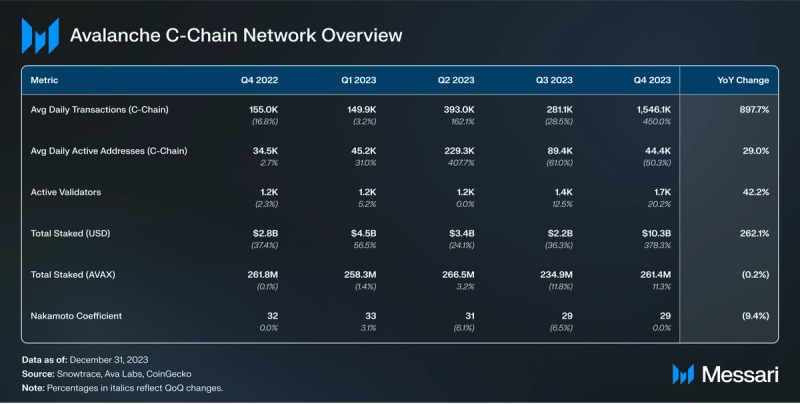
Usage

Daily transactions surged in Q4, rising 450% QoQ to 1.5 million. This dramatic increase was mainly due to the emergence of the aforementioned Avascriptions. C-Chain hit an all-time high of 6.3 million transactions on November 22, surpassing the previous all-time high of 1.1 million on January 27, 2022. Of these 6.3 million transactions, nearly 6.1 million were inscriptions. Additionally, during the month of December, C-Chain had a daily average of 3.4 million transactions, by far the largest daily average for any month in Avalanche’s existence.
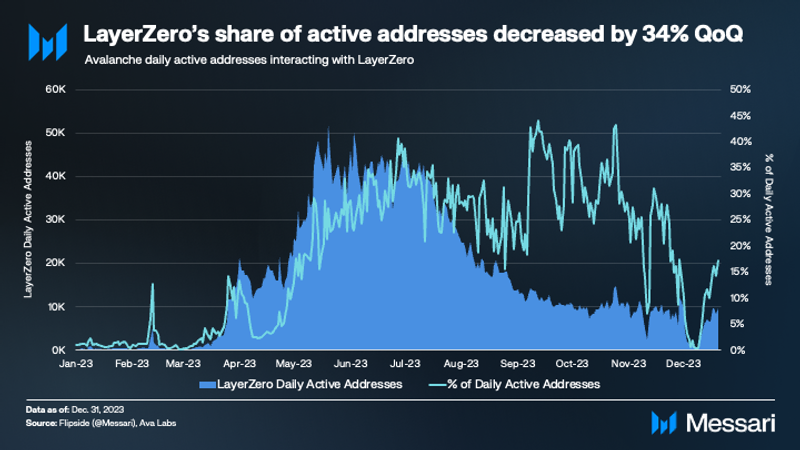
Despite the increase in transactions, average daily active addresses on C-Chain were down 50% QoQ from 89,400 to 44,400. However, this was primarily due to decreasing LayerZero activity. In Q2, activity spiked on Avalanche and other networks most likely driven by airdrop farming related to LayerZero.
In Q4, however, daily addresses interacting with LayerZero decreased by 67% QoQ, from 26,000 to 8,500. Additionally, the percentage of daily addresses interacting with LayerZero decreased by 34% QoQ from 29% to 19%. The biggest drops in daily activity related to LayerZero occurred at the same time during periods of high inscription activity on C-Chain.
Security and Decentralization
Avalanche uses a Proof-of-Stake consensus mechanism known as “Avalanche Consensus.” Avalanche’s P-Chain is responsible for validator coordination and staking operations. Both C-Chain and X-Chain utilizes the entire P-Chain validator set for consensus. To determine if a transaction is valid, validators on Avalanche use repeated sub-sampling voting of a small, random subset of all validators. Consensus occurs once a sufficient majority of validators agree over a consecutive number of rounds. Both the necessary majority and consecutive rounds are configurable. Additionally, the more tokens staked/delegated to a validator, the more influential that validator is in the consensus process.
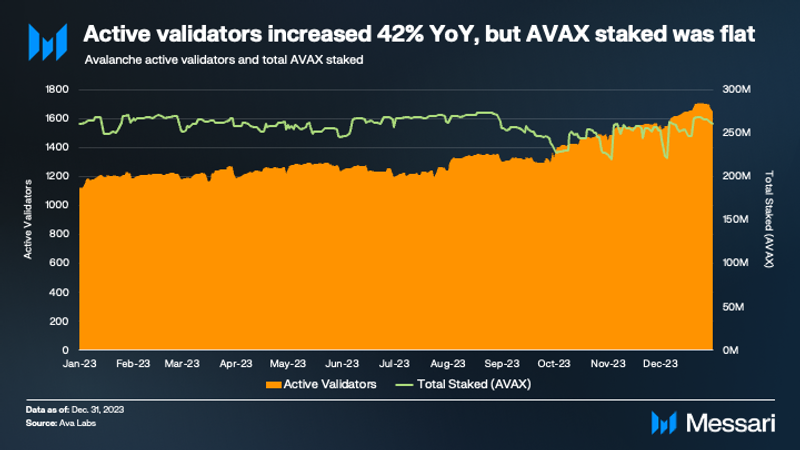
Q4’23 saw a significant increase in active validators, growing 20% QoQ from 1,374 to 1,651 validators. Over the course of 2023, Avalanche experienced healthy validator growth, increasing by 42% YoY.
Total AVAX staked was essentially flat YoY, decreasing from 261.8 million to 261.4 million AVAX. However, there was a significant increase in AVAX staking during Q4 (up 11% QoQ). Given that this increase coincided with a significant increase in the price of AVAX, it could be signaling a genuine longer-term appetite for AVAX for the next year.
The Nakamoto coefficient is the number of node operators that collectively control more than 33% of the network. The higher the coefficient, the more resilient a network is to attacks and bugs. Although the number of validators on Avalanche increased throughout 2023, the Nakamoto coefficient decreased by 9% YoY from 32 to 29. Despite this decrease, Avalanche remains above the median of other PoS networks.
Technical Developments
Avalanche released a series of upgrades which were optional for validators in Q4, including
- Cortina 12 (October 10) – Consensus optimization, eventual dual-alpha support, and configurable MerkleDB branching factors.
- Cortina 13 (October 17) – Memory improvements in MerkleDB path generation and the addition of a prefetcher interface.
- Cortina 14 (October 26) – Redesign of validator set management, added PebbleDB implementation, and optimization improvements.
- Cortina 15 (November 1) – Experimental support for PebbleDB and memory optimizations.
- Cortina 16 (November 22) – Optional indexing for C-Chain transactions and subnet tracking improvements.
- Cortina 17 (December 1) – Fixed a synchronization error related to C-Chain, speed improvements related to wallets, and added verification support for Avalanche Warp Messages (AVM) on C-Chain.
Avalanche took a major step forward in October with the introduction of Avalanche Community Proposals (ACPs). ACPs are a framework for any community member or developer to propose changes or implementations to the Avalanche network. ACPs are similar to other offchain governance frameworks, such as Bitcoin Improvement Proposals (BIPs) or Ethereum Improvement Proposals (EIPs), where it is ultimately up to the network’s nodes to implement any approved network upgrades. Although no ACPs were implemented in Q4, there have been eight ACPs created as of writing, six of which are ready to be implemented:
- ACP-23: P-Chain Native Transfers – To enable native transfers for assets on P-Chain.
- ACP-24: Activate Shanghai EIPs on C-Chain – To implement four EIPs that were included in Ethereum’s Shanghai upgrade on C-Chain.
- ACP-25: Virtual Machine Application Errors – To enable a way for virtual machines (VMs) to communicate error conditions to one another.
- ACP-30: Integrate Avalanche Warp Messaging into the EVM – To implement cross-subnet communication to the C-Chain and EVM subnets.
- ACP-31: Enable Subnet Ownership Transfer – To allow the current owner of a subnet to transfer ownership
- ACP-41: Remove Pending Stakers – To start the staking period for a staker as soon as the staking transaction is confirmed.
Lastly, the Teleporter Developer Preview went live in December. Teleporter is a smart contract cross-subnet communication protocol with EVM compatibilities for Avalanche. As a part of the Developer Preview, developers can create a local Avalanche devnet, spin up an AVM relayer, and deploy Teleporter using a single command. Additional information related to the AVM and Teleporter can be found here.
Subnets
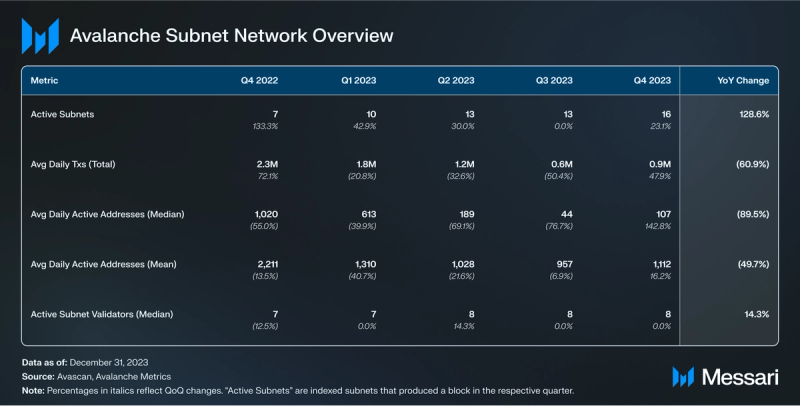
To join the Avalanche architecture, every subnet must provide at least one validator to the Primary Network (staking 2,000 AVAX). For its own consensus, each subnet utilizes anywhere from three to all P-Chain validators. There were 16 indexed Avalanche subnets that produced a block in Q4 including:
- Beam (Q4 Launch)
- Blitz (Q4 launch)
- Cloudverse (Q4 launch)
- DFK
- Dexalot
- Hubble Exchange (Q4 launch)
- Green Dot (Q4 launch)
- MELD
- NUMBERS
- ONIGIRI (Q4 Launch)
- PLAYA3ULL Games
- Shrapnel
- Step Network
- UPTN
- XANA
Subnets that were active in Q3 but not Q4 include Mintara and XPLUS.
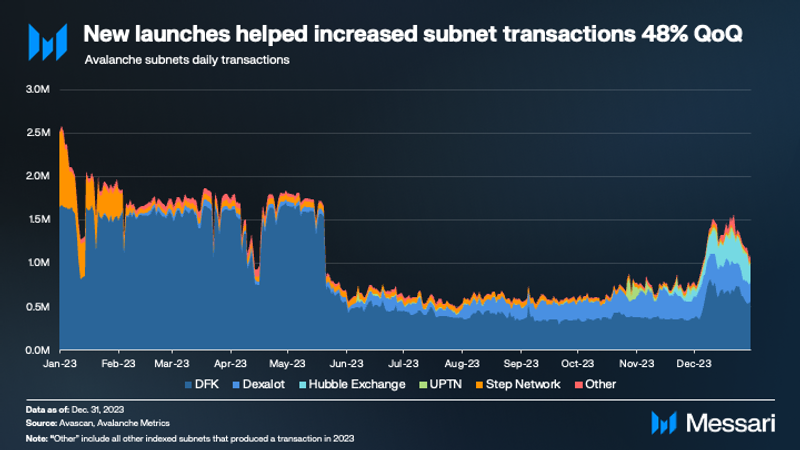
Daily average transactions rebounded in Q4 after three straight quarters of decline, finishing up 48% QoQ from 599,000 to 886,100. Part of this increase was due to new subnet launches. Hubble Exchange, a perpetuals decentralized exchange, launched in Q4 and had 7.9 million transactions, ranking it #3 across all subnets for the quarter. Other noteworthy subnets include DFK (up 16% QoQ to 42 million transactions, rank #1), Dexalot (up 88% QoQ to 23.8 million transactions, rank #2), UPTN (up 616% QoQ to 2.9 million transactions, rank #4), and Step Network (down 44% QoQ to 2.5 million transactions, rank #5).
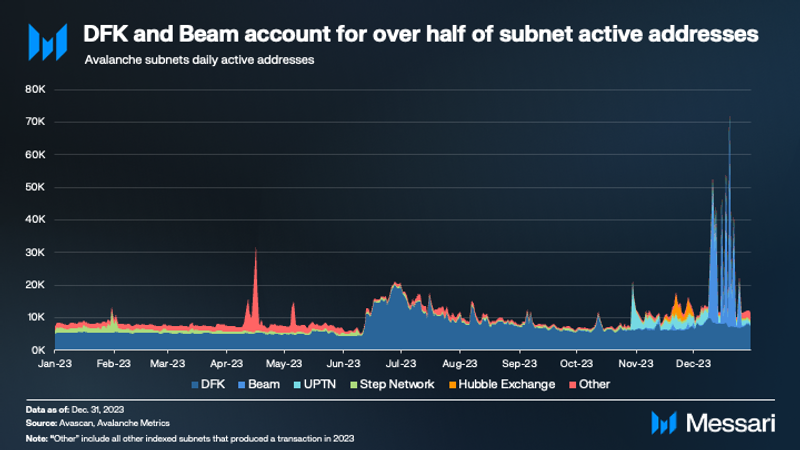
Active addresses on subnets saw impressive growth in Q4, with both the median (up 143% QoQ to 107 active addresses) and mean (up 16% QoQ to 1,112 active addresses) increasing. The vast majority of active addresses come from gaming subnets DFK and Beam. Although daily average active addresses on DFK were down 26% QoQ to 6,934, DFK still had the most active addresses by an order of magnitude. Beam ranked #2 for the quarter, increasing 41,013% QoQ from 9 to 3,656. Other notables include UPTN (up 24,651% QoQ to 1,633, rank #3), Step Network (up 449% QoQ to 596, rank #4), and Hubble Exchange (Q4 launch, 661, rank #5).
Ecosystem Overview
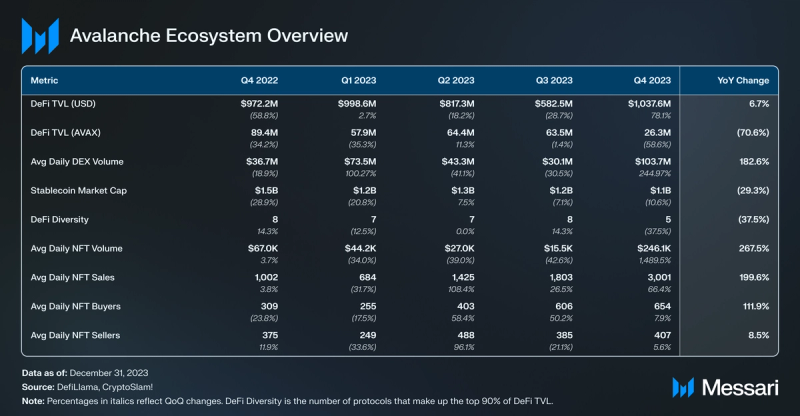
DeFi
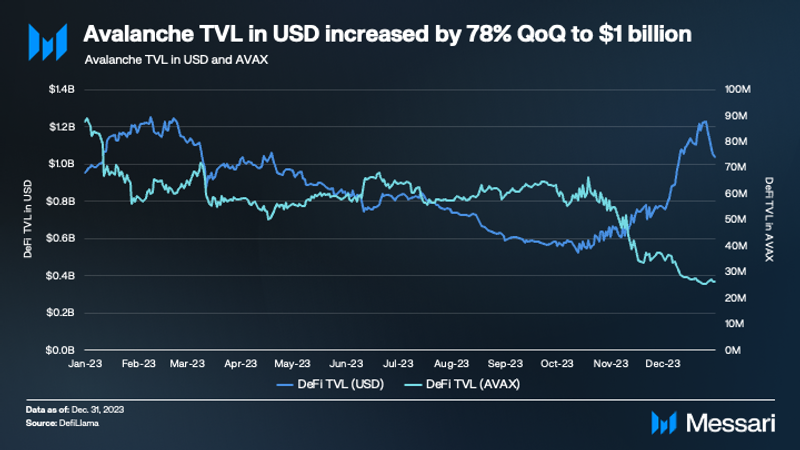
Avalanche TVL denominated in USD increased from $582.5 million in Q3 to $1.03 billion in Q4, up 78% QoQ. This ranked Avalanche as the 7th chain by TVL denominated in USD by the end of 2023. However, TVL denominated in AVAX decreased QoQ by 71% from 63.5 million AVAX to 26.3 million AVAX. This dynamic indicates that the TVL increase in USD was driven in part by AVAX price appreciation.
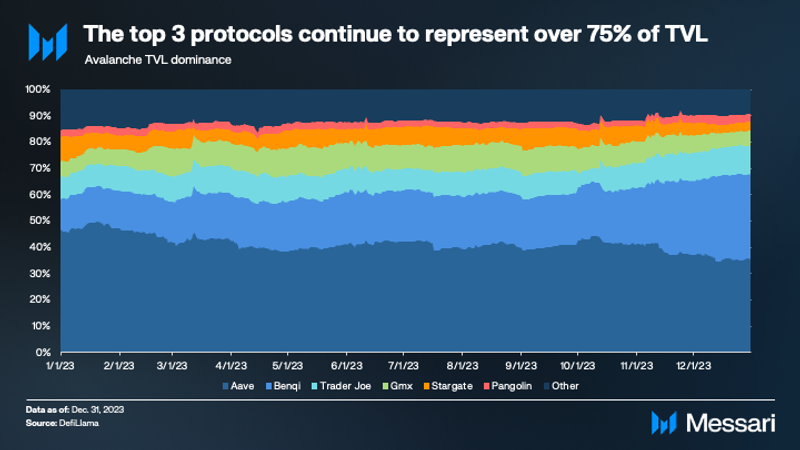
The top three protocols on Avalanche’s share of TVL grew in Q4. AAVE, the largest protocol by TVL on Avalanche grew 60% QoQ from $237.9 million to $380.1 million. However, AAVE’s TVL dominance actually decreased by 14% QoQ, due to strong gains from both Benqi (up 205% QoQ to $347.7 million) and Trader Joe (up 131% QoQ to $118.5 million). In sum, these three protocols’ share of TVL was up 14% QoQ from 69% to 79%.
Smaller-sized protocols also posted strong performances in Q4. Notable protocols include Pangolin (up 147% QoQ to $32.8 million) and GMX (up 18% to $62 million). The only protocol in the top six with decreased TVL was Stargate (down 7% to $38 million).
Popular DEXs Uniswap and Balancer launched on Avalanche in Q3. By Q4 end, Uniswap had attracted $3.5 million in TVL while Balancer was at $20.6 million in TVL, ranking in 10th among all protocols on Avalanche. Additionally, more than half of Balancer’s TVL on Avalanche is due to Benqi’s sAVAX liquidity pool.
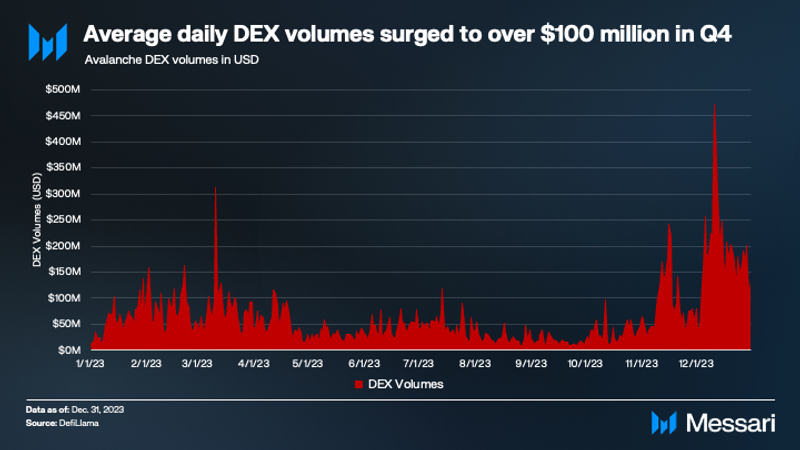
Average daily DEX volumes surged during Q4, rising 245% QoQ from $30.1 million to $103.7 million. The increase was a welcomed sight for community members after two straight quarters of decline, mostly attributable to DEX volumes decreasing across all networks during Q2 and Q3. Over the full year, average daily DEX volumes increased 183% from $36.7 million.
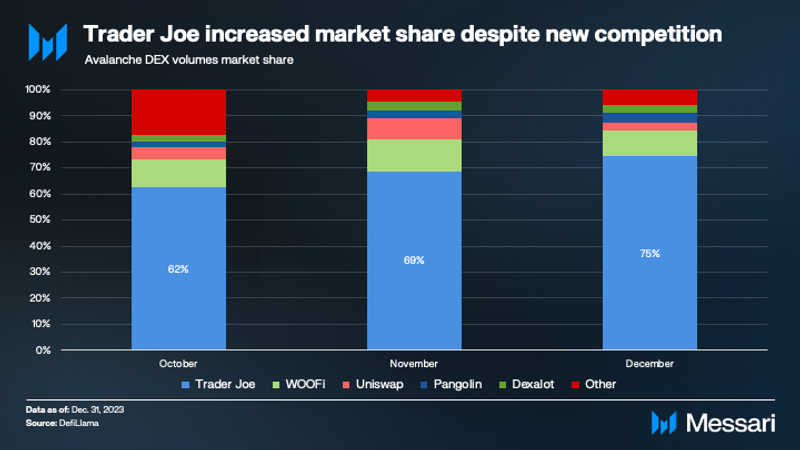
By the end of 2023, there were 30 different DEXs on Avalanche, with the aforementioned Uniswap and Balancer being two notable additions in 2023. Despite the increased competition, leading DEX Trader Joe still increased its market share, representing 75% of all DEX volumes during the month of December. This was a 21% increase from its 62% share of DEX volumes in October. For Q4, the top five DEXs by trading volume were:
- Trader Joe – $6.84 billion (72% of Avalanche DEX volume)
- WOOFi – $1.01 billion (11% of Avalanche DEX volume)
- Uniswap – $438.6 million (5% of Avalanche DEX volume)
- Pangolin – $330.8 million (3% of Avalanche DEX volume)
- Dexalot – $291.7 million (3% of Avalanche DEX volume)
Stablecoins
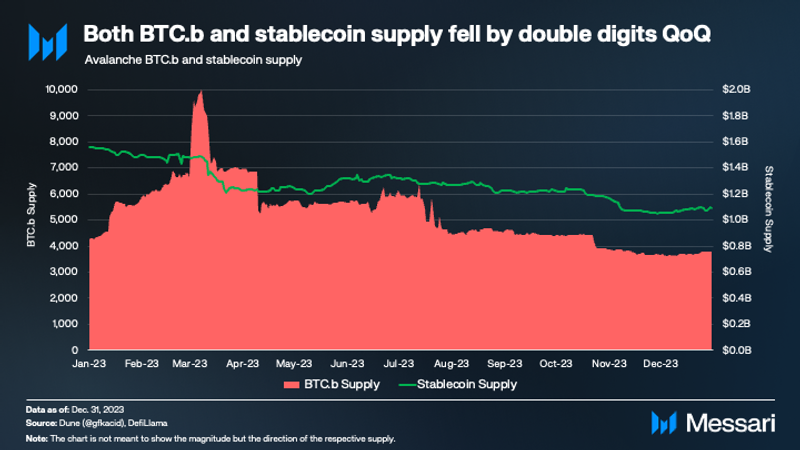
Stablecoins and BTC.b are two of the largest assets on Avalanche besides AVAX. BTC.b is a token that represents Bitcoin on Avalanche and can be automatically bridged in Core. Compared to other natively bridged Bitcoin assets, BTC.b allows users to freely transfer native Bitcoin without relying on custodians.
Despite a surge in Q2, the supply of BTC.b finished down 12% YoY in 2023, from 4,271 to 3,777 BTC.b. This decrease may be due in part to the emergence of ordinals and the wider Bitcoin ecosystem in 2023. Stablecoins on Avalanche also ended 2023 down 30% YoY from $1.56 billion to $1.09 billion. Despite the decrease, Avalanche remains one of the top networks by stablecoin market capitalization, ranked seventh. Fiat-backed stablecoins like USDT and USDC represent over 90% of the stablecoin market cap on Avalanche.
Enterprise and RWAs
One of Avalanche’s main initiatives for 2023 was to onboard institutions and enterprises onto the network. In Q2, Evergreen subnets launched, which allow anyone to create a subnet with customizable KYC/AML requirements and unique privacy capabilities. In Q4, Avalanche announced the following partnerships related to Evergreen:
- J.P. Morgan – In November, J.P. Morgan announced that its bank-led blockchain platform, Onyx, would be utilizing LayerZero to connect to a permissioned Evergreen subnet. This collaboration was part of a broader initiative called Project Guardian, a collaboration between the Monetary Authority of Singapore (MAS) and the financial industry. Through this partnership, WisdomTree Prime demonstrated a proof-of-concept where it could facilitate subscriptions and redemptions for its fund product offerings.
- Citi – Also in November, Avalanche announced that Citi used permissioned Evergreen subnets to execute foreign exchange swaps as a part of Project Guardian. The subnet was built in collaboration with AvaCloud, a custom blockchain service provider. The application being built could be used for trading any currency pair.
Outside of Evergreen, Republic launched Republic Note, a profit-sharing digital asset that represents investments in over 750 different companies, on INX Group’s Avalanche-powered trading platform. Trading for Republic Note went live on December 6. This initiative was a part of the Avalanche Foundation’s Vista Program, a $50 million program that aims to tokenize real-world assets and bring them onto the Avalanche network.
NFTs, Gaming, and Culture
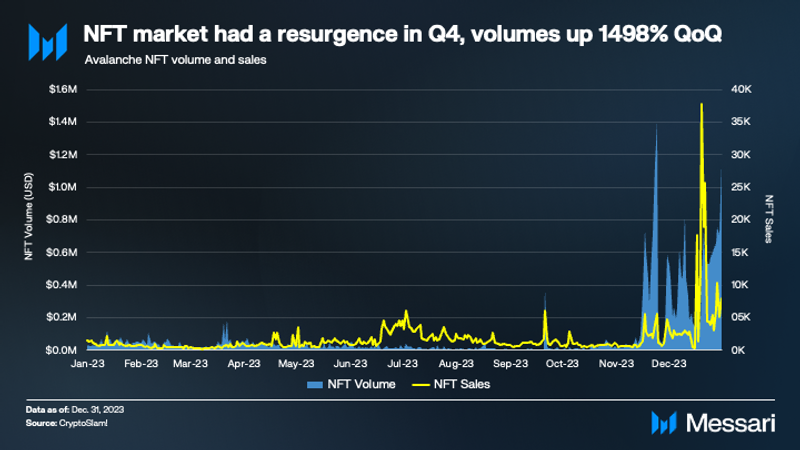
Avalanche’s NFT market had a resurgence in Q4, with relevant metrics up across the board. The average daily NFT trading volume increased by 1,498% QoQ and 270% YoY to $247,400. There was also impressive growth in both the number of sales and buyers for NFTs. Average daily sales were up 200% QoQ from 1,800 to 3,000, while average daily buyers were up 112% from 606 to 654. The biggest catalyst for Avalanche’s NFT revival has been the launch of Hyperspace, a multichain NFT marketplace. In October, Avalanche Foundation announced an incentives program for Hyperspace, which rewards users with AVAX tokens. In the first season alone, over 50,000 AVAX was rewarded to Hyperspace users.
The most popular NFT collection during Q4 was Dokyo, an NFT venture studio, which launched earlier in the year in September. Dokyo NFTs did $13.6 million in volume during Q4, accounting for nearly 60% of Avalanche’s NFT volume during Q4 ($22.8 million).
Q4 was another busy quarter for gaming on Avalanche, with the following notable events:
- Beam Subnet Launch – Merit Circle launched a gaming-focused subnet on Avalanche called Beam. The subnet went live on October 24, and usage later became permissionless on November 6. The Beam subnet supports a variety of different products, such as a gaming platform, NFT marketplace, decentralized exchange (DEX), and an SDK for developers.
- Solert Subnet Launch – On November 30, Solert Games launched its Solert subnet on Avalanche. The subnet aims to bring various aspects of the mobile Play-to-Earn (P2E) game Law of Kingdoms onchain, such as the LAW token. Additionally, Solert Games plans on launching additional games on the Solert subnet in 2024.
- Mirai Subnet Launch – Mirai Labs launched the Mirai subnet on Avalanche on December 12. The subnet hosts Mirai Labs’ full product suite, including the “free-to-play racing game Pegaxy, Petopia with its new SocialFi esports-style integration, the native token $PGX, Mirai ID, the Mirai App, and Mirai Pay.” Mirai is also implementing SocialFi mechanics on its subnet through GuildTech, which enables players to earn rewards by owning a piece of any guilds they are in.
- T1, a popular e-sports team, partnered with UPTN to launch NFT collectibles on the UPTN subnet.
- Neon Machine completed a $20 million Series A fundraising round to further fund the development of its upcoming first-person shooter (FPS) game, Shrapnel.
- Tiltyard announced that it would be launching an Avalanche subnet to support the onchain mechanics of its upcoming strategy game called Midnight Heist.
Across all of crypto, Q4 brought a “memecoin season” that took place across various networks. Avalanche was no exception, with various memecoins gaining popularity, specifically during December. Following this renewed frenzy, the Avalanche Foundation announced on December 28 that the Foundation would strategically begin supporting various Avalanche memecoins as a part of the Culture Catalyst initiative. The Avalanche Foundation will determine which memecoins should be supported by evaluating key criteria such as liquidity, holder counts, project maturity, virality, and more.
Ecosystem Growth
Avalanche continued to support and grow its ecosystem during Q4. Avalanche’s major initiative for the quarter, and 2024, is Avalanche Codebase. Codebase is a 12-week accelerator program that aims to support early-stage Web3 projects building on Avalanche.
A total of 15 different projects will be chosen for the program. Each of the selected projects will receive a stipend of $50,000 and the chance to receive a prize from an investment pool of $400,000. Additionally, projects will receive support, mentorship, and services from the following partners:
- Web2 Partners – Amazon Web Services (AWS), Google Cloud, Carta, deel, and Brex.
- Web3 Partners – Chainlink, Circle, Chainstack, OpenZeppelin, Fireblocks, BitGo, and Biconomy.
Participants had until February 12, 2024 to apply, and the winning projects will be announced on March 18.
Closing Summary
Avalanche’s strong Q4 performance marked the end of an impressive 2023. Despite the enduring bear market, Avalanche finished 2023 with many important metrics up YoY, including market cap (325%), revenue in USD (3,811%) and AVAX (1,432%), active subnets (129%), and average daily DEX volume (183%). Avalanche showcased in 2023 that it will continue to build and grow, regardless of wider market conditions.
Avalanche was spurred on by its multifaceted ecosystem, which made progress across multiple fronts in 2023 (gaming, DeFi enterprise, culture, etc.). Major gaming subnets such as DFK, Beam, and Shrapnel should continue to drive increased usage of Avalanche in 2024, while partnerships with J.P. Morgan and Citi should lead to more enterprise adoption and the growth of tokenized real-world assets.
Finally, Avalanche Codebase will play a significant role in Avalanche’s ecosystem growth during Q1, with winning projects being announced in March.



















